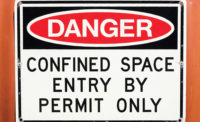Training Strategies: Keys for conducting a safety meeting on the construction site

Whether it’s a formal safety meeting set up in a classroom, or a weekly toolbox talk on the jobsite, preparation is key to successful training. If you’re on a construction site, here are some tips for properly setting up a classroom-style construction safety meeting.
Be prepared
Always prepare, whether it’s the first or 51st time you’ve presented the material. Use the following basic checklist for safety meeting preparation:Training checklist
- Begin by reviewing any regulatory requirements you may need for the given subject. For instance, in the scaffold rule, scaffold users must be trained by a person qualified in the subject matter. That may influence your timing and scheduling.
- Go over the conditions at each jobsite. Be sure you are thoroughly familiar with the operations and any changes in the procedure that may have occurred since the last training session.
- Review videos or other training aids you might use. Make sure you understand the program content before delivering the training session.
- Verify the number of workers to be trained at a given session (including notification of their supervisors, if necessary) and their schedules. This will influence a variety of other decisions to be made.
- Decide when and where the class will be held. If this has been done, make sure the area or room is reserved for your class. Make sure that any working areas have been reserved for your training if you’re doing “hands-on†training or demonstrations.
- Determine if you need audio-visual equipment, such as a laptop computer, video player or overhead projector.
- Make a list of all materials you’ll need for the session, including writing tools, easel pads, pointers, etc.
- Make photocopies of related company policies, procedures or other handouts.
- Get any necessary samples of equipment, signs, labels, etc.
- Get to the training site early and verify that preparations have been made.
- Set up all equipment before the session starts. Cue up all audio-visual equipment and make sure your laptop or video tapes are working and will start where you need them.
Know your audience
When planning your safety meeting it is helpful to have some background information about the group you will be training. The more you know about the trainees, the better you can tailor the training experience to suit their needs:- Are they all jobsite workers, office workers, or a mixture of both?
- What is the average age and experience level?
- Do they all perform similar jobs or do they come from a wide range of skills?
- What is the literacy level of the group?
- Is English the native language for the group?
- What is the education level of the group?
- What are the job skills of the group?
Notify attendees
You also need to send out notice of your safety meeting. This may be done via email, memo, company newsletter, word-of-mouth or posting a notice on the bulletin board.Or, you could create some excitement about the meeting by doing something out of the ordinary or untraditional. For example, you could announce that you’ll pick one prize-winner from among those employees who show up to the meeting on time.
Vary training techniques
A training program should be designed to build awareness, understanding and a better attitude toward safety. The primary purpose of safety training is to have employees transfer the knowledge and safety skills to their everyday job activity.Critical to this learning process is the way the training is prepared and presented. It is a good idea to use several different training techniques in the same session to convey your points.
Different people learn different ways. Using various training techniques helps assure that each person will understand the information presented and will be able to apply it to his or her job.
Information retention increases through repetition and the use of multiple delivery methods. Research shows that for most people, only 10 percent of information is retained through reading alone, without any kind of reinforcement through other training techniques.
Using videos can help, because retention of information shown on video is higher. When you factor in discussion and practice, retention levels increase to more than 50 percent.
Types of training techniques include:
- A question and answer period
- Demonstration
- Discussion
- Simulation of a potentially dangerous situation and the proper and improper responses
- Drills or exercises in which everyone takes part
- Hands-on demonstration of safety equipment or devices
- Video and/or audio tapes
- Interactive software programs
- Written materials and handouts
- PowerPoint® presentations
- Visual cues on a blackboard or overhead projector.
Fine-tuning
Before the trainees leave, have them fill out an evaluation form. This feedback may generate ideas for improving the training for next time. Then, immediately after the attendees have left, take a minute to reflect on the training session and jot down any thoughts you have on fine-tuning it. You can also measure the effectiveness of the training session by following up with the attendees a week later to see what they remember.Sidebar: Presentation techniques
- Be enthusiastic.
- Be prepared.
- Start and end on time.
- Prepare the group to learn — Explain why you are doing the training and how it applies to the audience.
- Handle questions properly — When questions are asked, repeat the question in your own words before answering. Also, build your own questions into your presentation to spur group involvement.
- Recap the training.
Looking for a reprint of this article?
From high-res PDFs to custom plaques, order your copy today!





